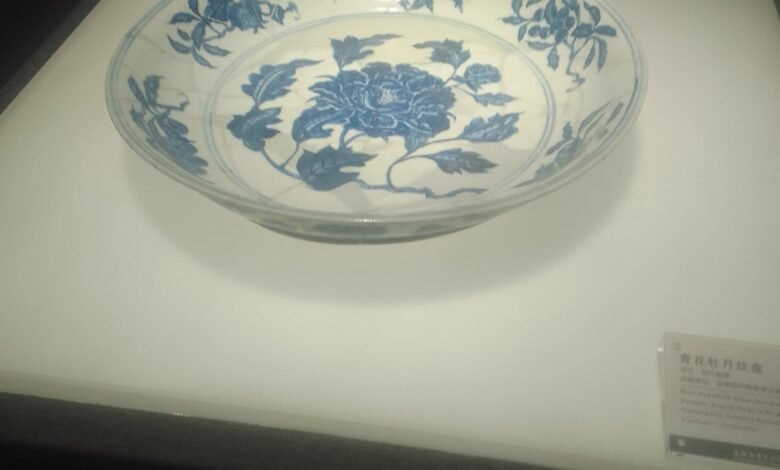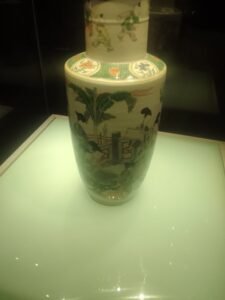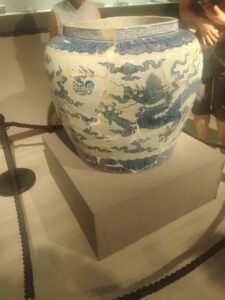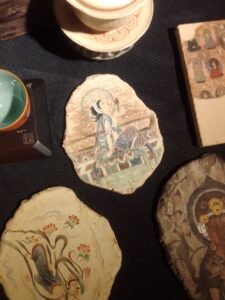مقاصد مدينة جينغدتشن السياحية: سوق البورسلين ومتحف الخزف (8)
العالم الآثاري المصري الدكتور محمد شبانة يكتب :

البورسلين ومتحف الخزف (8).
أ- سوق البورسلين
يُعد سوق خزف جينغدتشن من أبرز الوجهات التجارية والثقافية لعشّاق الخزف الصيني التقليدي والحديث. يقع في قلب المدينة التي تُعدّ مهد صناعة الخزف في الصين، ويضم مئات المحلات والأكشاك التي تعرض قطعًا خزفية فريدة، من الأواني اليومية إلى التحف الفنية النادرة. يتميّز السوق بتنوّع أساليبه الفنية، حيث يمكن للزائر مشاهدة أنماط من مختلف الحقب، وخاصة من عهدي مينغ وتشينغ.
يشتهر السوق أيضًا بأنه مركز للتفاوض المباشر بين الحرفيين المحليين والمشترين من حول العالم، مما يخلق تجربة ثقافية وتجارية مميزة.هذا ويُقام فيه بانتظام معارض موسمية وأسواق مفتوحة تجذب الزوار والمهنيين والمقتنين, ويُعدّ السوق اليوم مرآة حيّة لتاريخ مدينة جينغدتشن ولمستقبل خزفها، جامعًا بين الحرفة التقليدية وروح الابتكار.
متحف الخزف الصيني في جينغدتشن: مرآة الحضارة الخزفية الصينية ب.
يُعد متحف الخزف الصيني في جينغدتشن من أعرق وأهم المؤسسات المتخصصة في عرض وتوثيق تاريخ الخزف الصيني العريق, تأسس المتحف في قلب المدينة التي تُعد موطن الخزف الإمبراطوري منذ قرون، ويقدّم للزوار رحلة متكاملة عبر تطوّر هذه الحرفة من العصور القديمة حتى العصر الحديث.
يضم المتحف مجموعات نادرة من القطع الخزفية التي تعود إلى عصور أسرات تانغ، سونغ، يوان، مينغ، وتشينغ، ويتميّز بأسلوب عرض تفاعلي يعكس الأساليب الفنية والتقنيات المختلفة التي ازدهرت في كل فترة.
يمتد المتحف على عدة قاعات، من أبرزها قاعة الأفران الإمبراطورية، وقاعة الخزف الشعبي، وقاعة الخزف المعاصر، إضافة إلى قسم مخصص لتقنيات الحرق والتزجيج التقليدية تُعد قاعة الأفران الإمبراطورية من أكثر القاعات جذبًا للزوار، حيث تعرض نماذج طبق الأصل من الأفران التي كانت تُستخدم لإنتاج الخزف الخاص بالبلاط الإمبراطوري. وتُظهر هذه القاعة تفاصيل دقيقة عن درجات الحرارة، وتركيب الأفران، وآليات الحرق التي كانت تُضفي جمالًا وندرة على القطع المنتجة.
كما يضم المتحف مختبرات علمية حديثة تعمل على فحص وتحليل التكوينات الخزفية والزخرفية باستخدام تقنيات متقدمة مثل التحليل الطيفي والمسح الرقمي, وتُستخدم هذه المختبرات في الترميم الدقيق للقطع المتضررة وتوثيق خصائصها الكيميائية والمعدنية.
إلى جانب العرض، يضم المتحف مراكز أبحاث، ويعمل على توثيق وتحليل النماذج الزخرفية من مختلف الحقب, كما يُنظّم ورش عمل ومعارض دورية تُعزز الوعي العالمي بأهمية الخزف الصيني.
واحدة من أبرز سمات المتحف هي دمجه بين الأصالة والحداثة، حيث يستخدم تقنيات العرض الرقمية والواقع المعزز (AR) لتقريب التجربة للزائر بطريقة تعليمية جذابة. وتُستخدم الشاشات التفاعلية والنماذج ثلاثية الأبعاد لتوضيح خطوات صناعة الخزف منذ الحفر وحتى الحرق.
وفي بعض القاعات، يمكن للزائر استخدام نظارات الواقع الافتراضي لتجربة الوقوف داخل فرن إمبراطوري افتراضي، أو متابعة مراحل تلوين القطع الخزفية كما كانت تتم قبل قرون يستقطب المتحف آلاف الزوار سنويًا، من الباحثين والطلاب وحتى السائحين، ويُعد اليوم مرجعًا عالميًا لدراسة الخزف كموروث ثقافي وفني، ومثالًا حيًا على كيفية صون التراث باستخدام أدوات المستقبل. (يُتبع)

“My Journey to China Series: “Jingdezhen Tourist Attractions: Porcelain Market, Ceramics Museum”” (8) by Dr. Mohamed Shabana, Egyptian Archaeologist.
A- The Jingdezhen Porcelain Market is one of the most prominent commercial and cultural destinations for lovers of traditional and modern Chinese porcelain. Located in the heart of the city known as the cradle of Chinese ceramics, it features hundreds of shops and stalls offering unique porcelain pieces, ranging from daily-use wares to rare artistic collectibles. The market is known for its stylistic diversity, showcasing designs from various historical periods, especially the Ming and Qing dynasties.
It is also famous as a hub for direct negotiation between local artisans and international buyers, creating a rich cultural and commercial experience. Seasonal exhibitions and open-air fairs are regularly held, attracting visitors, collectors, and professionals. Today, the market stands as a living reflection of Jingdezhen’s history and the future of its porcelain blending traditional craftsmanship with a spirit of innovation.
B- The China Ceramics Museum in Jingdezhen: A Mirror of Chinese Ceramic Civilization
The China Ceramics Museum in Jingdezhen is one of the most prestigious and significant institutions dedicated to showcasing and preserving the rich history of Chinese ceramics. Founded in the heart of the city known as the imperial center of porcelain for centuries, the museum offers visitors a comprehensive journey through the development of this craft from ancient times to the modern era.
The museum houses rare collections of porcelain pieces dating back to the Tang, Song, Yuan, Ming, and Qing dynasties. It features interactive displays that highlight the artistic styles and techniques that flourished in eachperiod.
The museum is divided into several halls, most notably the Imperial Kiln Hall, the Folk Ceramics Hall, and the Contemporary Ceramics Hall, in addition to a section dedicated to traditional firing and glazing techniques.
The Imperial Kiln Hall is one of the museum’s main attractions, showcasing life-size replicas of the kilns once used to produce porcelain for the imperial court. This hall reveals intricate details about temperature control, kiln structure, and firing methods that gave imperial porcelain its distinct beauty and rarity.
The museum also features modern scientific laboratories equipped to examine and analyze the composition and decorative features of ceramics using advanced techniques such as spectroscopy and digital scanning. These labs support precise restoration processes and document the chemical and mineral properties of the artifacts.
In addition to exhibitions, the museum hosts research centers that document decorative patterns from various eras. It regularly organizes workshops and special exhibitions that promote global awareness of Chinese ceramic heritage.
One of the museum’s most distinctive features is its integration of tradition and innovation, using digital display technologies and augmented reality (AR) to enhance the visitor experience in an educational and engaging way. Interactive screens and 3D models illustrate each step of the porcelain-making process, from clay shaping to kiln firing.
In some halls, visitors can wear virtual reality headsets to explore reconstructed imperial kilns or watch the ancient painting techniques being performed in an immersive environment.
The museum attracts thousands of visitors annually, including researchers, students, and tourists. Today, it stands as a global reference in ceramic studies and a living example of how heritage can be preserved through the tools of the future. …to be continued



